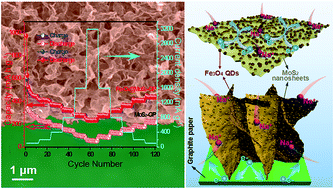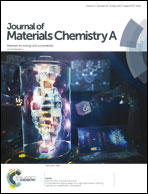Fe3O4 quantum dot decorated MoS2 nanosheet arrays on graphite paper as free-standing sodium-ion battery anodes†
Abstract
A novel composite consisting of vertical ultrathin MoS2 nanosheet arrays and Fe3O4 quantum dots (QDs) grown on graphite paper (GP) as a high-performance anode material for sodium-ion batteries (SIBs) has been synthesized via a facile two-step hydrothermal method. Owing to the high reversible capacity provided by the MoS2 nanosheets and the superior high rate performance offered by Fe3O4 QDs, superior cycling and rate performances are achieved by Fe3O4@MoS2-GP anodes during the subsequent electrochemical tests, delivering 468 and 231 mA h g−1 at current densities of 100 and 3200 mA g−1, respectively, as well as retaining ∼72.5% of their original capacitance at a current density of 100 mA g−1 after 300 cycles. The excellent electrochemical performance resulted from the interconnected nanosheets of MoS2 providing flexible substrates for the nanoparticle decoration and accommodating the volume changes of uniformly distributed Fe3O4 QDs during the cycling process. Moreover, Fe3O4 QDs primarily act as spacers to stabilize the composite structure, making the active surfaces of MoS2 nanosheets accessible for electrolyte penetration during charge–discharge processes, which maximally utilized electrochemically active MoS2 nanosheets and Fe3O4 QDs for sodium-ion batteries.



 Please wait while we load your content...
Please wait while we load your content...